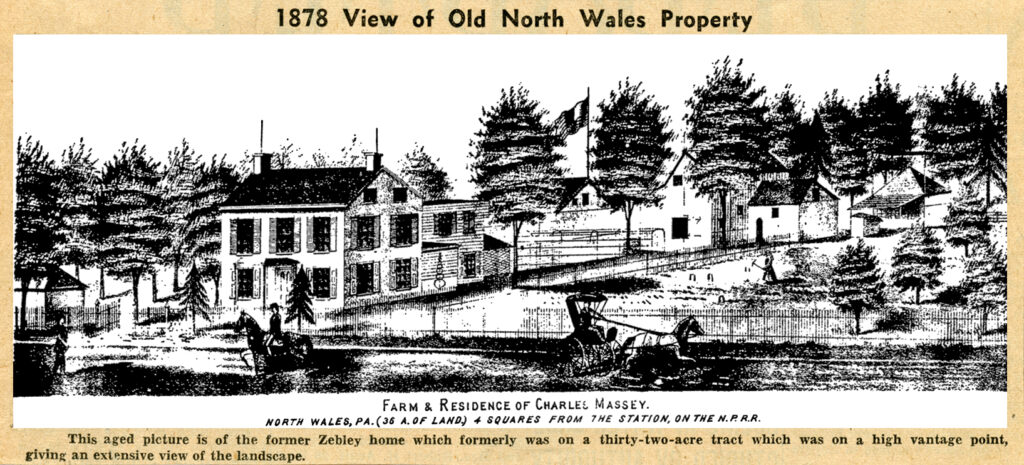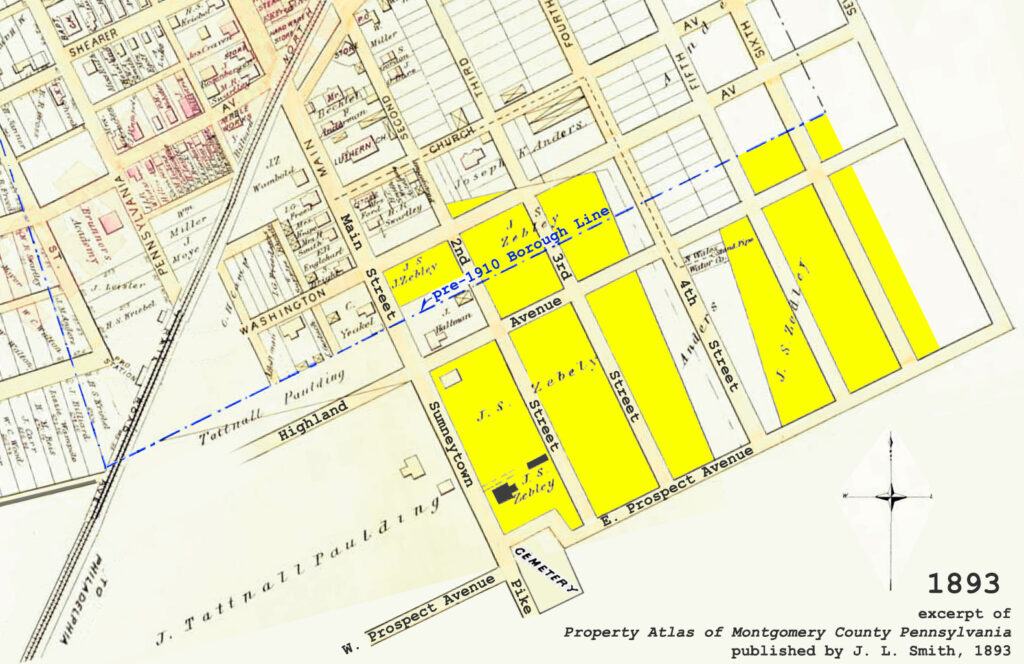The buildings on the former Zebley property were on the top of the hill on the southeast side of North Wales.
Here was a two story stone and brick house, plastered on the outside, close to the northeast side of Main street and well surrounded by shade trees. A lane was at the side of the house which lead to the barn in the rear. This was a farm of 32 acres, but it had been largely cut up into building lots and dwellings erected thereon. This farm formerly extended along the summit of the ridge to the crossroads, or the extension of Fifth street, while the lower boundary was the road (Prospect avenue), passing the Lutheran Cemetery.

The farm comprised two tracts, one of twenty acres nearest the buildings, and one of twelve acres, composed of several smaller tracts.
On one of these near the lower road, or Prospect avenue, up until 1904 stood an ancient log house of one story, which was burned down in that year. From this point a most extensive view of the landscape, far to the north and northwest, and also to the south, can be obtained. This hill is a part of a high ridge extending across the country from the Delaware to the Schuylkill, only dipping down to allow the passage of streams, such as the Neshaminy and Wissahickon. Closely adjacent the Reading railroad passes through it by a deep cut.
This property is a fragment of the great tract of 720 acres, granted in 1770 by William Penn to Robert Johns, who was then one of the sixteen grantees to the whole township. of Gwynedd. This tract extended across the whole width of the township. He lived near the Kneedler tollgate, on the road running to West Point, where he built a house in 1712. His will of 1732 gave this to his son, John Jones.
At what time improvements were made on the top of the hill is not known. In 1758 Abraham Lukens bought 120 acres of John Jones, covering the site of North Wales. Prior to the Revolution, or in 1772, Lukens sold the same to Philip Heist, a German. In 1758 he had also sold 80 acres to his son, Abraham Lukens, Jr., and of which, in 1772, the latter sold 70 acres to Philip Heist. For all we know to the contrary he may have built a house here. His will was made in 1776, when he was the owner of 120 acres. A Welshman named Humphrey Hughes bought the most of this, or a house and 100 acres, in 1780. He paid, in inflated Continental currency, the sum of $16,800 pounds. In 1776 the assessor taxed Philip Heist for 120 acres, two horses and four cows.
The site of the Zebley house, and the lane surrounding it, was certainly a part of a tract of 20 acres sold to Matthias Booz, in 1781, by the executors of Philip Heist, and it was there that Booz, or Boaz, lived. He paid only 170 pounds for the tract and may have built the first house. These 20 acres were surrounded on the northwest side for 43 perches by land of Humphrey Hughes, also by land of Hughes on the northeast side for 78 perches.
On the southeast was the land of Martin Schwenk for 31 perches and the Lutheran Church lot, or Cemetery. The Great Road, or Main street, ran past it on the southwest for 32 perches.

Matthias Booz was a young man when he came here and he spent a long life thereafter on the top of the hill, where he lived for over forty years, or until 1823. He left at least three sons, Jacob, Samuel and John. The two former, as their fathers executors, sold the property to their brother, John H. Booz. The deed was not given until 1839. John H. Booz held the property until 1858. In that year he sold the farm to Silas C. Land, for $4000. The latter died without will, in January 1863. He left minor children for whom Jacob Acuff was made guardian. In 1863 Acuff sold the property, now increased to 32 acres, to David Smith, of Philadelphia, for $5700. During his ownership Silas Land had built a new brick house.
In 1870 David Smith conveyed the property over to his wife, Amanda Smith. They were the parents of Harry Smith, an early publisher of The North Wales Record. The next owner was Charles Massey, who bought the property in 1878. He was a painter and glazier and also came from Philadelphia. The next year, in 1879, the latter gave deed to Jacob S. Zebley, who came from the city of Elizabeth, New Jersey. The price was $6000 for the 32 acres. Zebley lived here for a quarter of a century, reaching the very advanced age of 90 years. His death took place on March 3rd, 1904. The house and seventeen acres were then sold to Andrew H. Tyson, who remodeled the house and lived in it until his death several years ago, after which it was occupied by his widow, who remained there until her recent death, when it was sold on January 10, 1957, to George B. Burpee, the present occupant.
John Booz was born July 1, 1790, and died August 23, 1871. His wife, Margaret, was born April 14, 1797, and died March 1, 1863. Both are buried in the Lutheran Cemetery.
Both Silas Land and wife died of spotted fever in January 1863. He being 46 years of age, while his wife was about 40 years of age.
All of the present houses between Summit street and Prospect avenue, and between Main street and Eighth are built upon the ground of this Zebley tract. The present North Wales Elementary School, and its adjoining grounds, occupies a large portion of this original tract.
It being the purpose of these articles to give the history of North Wales and its early residents, we feel it is proper at this time since we have just given the history of the Zebley farm, to relate the background of Jacob W. Zebley, who was one of the most colorful of our early residents. Therefore next week we will devote part of our article to Mr. Zebley.
This post is sourced from a column entitled Early North Wales: Its History and Its People penned by long-time North Wales resident historian Leon T. Lewis. The article appeared in its original form in the April 7, 1959 issue of the North Penn Reporter.
